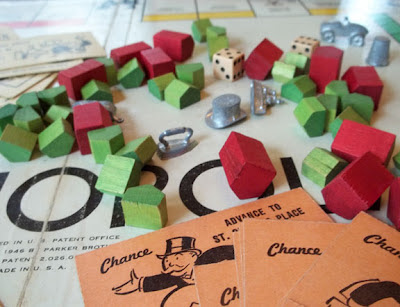The people who work for these estate sale companies also have a clear interest in and enjoyment of these old things. I don't know how they manage to avoid buying up all the best stuff themselves! There must be rules about that. For me, it would be a challenging and counterproductive job (I would end up spending more than I earned).
I was looking for games first, because I like to use the pieces in the mini toy collections I package in small tins and sell in my Etsy shop under the imaginative title Stuff! (Yeah, I didn't exactly use a focus group for that one, can you tell?)
I have often thought that it would be great to find a used Monopoly game some day, because few things have more little kid appeal than the fanciful game tokens used in Monopoly.
And, whaddya know, there was a Monopoly game — a very old one, possibly from the 1930s, with wooden houses! Apart from that, the game appears to have changed little, if at all. The board, the game tokens, the money and the Chance and Community Chest cards all look pretty much the same.
But then I saw another game I had never heard of before, Easy Money, and when I opened the box I was struck at how the little houses looked like Monopoly houses.
 |
| Easy Money game tokens and houses |
 | |
| Give-or -Take cards instead of Community Chest & Chance |
 |
| Easy Money wooden dice and houses |
 |
| The play money for this game is smaller than Monopoly money, at 1.5" x 3" |
World of Monopoly
Reference for Business (Company History Index)
The Play & Playground Encyclopedia




No comments:
Post a Comment
Thanks for reading, and for sharing your thoughts.
Note: Only a member of this blog may post a comment.